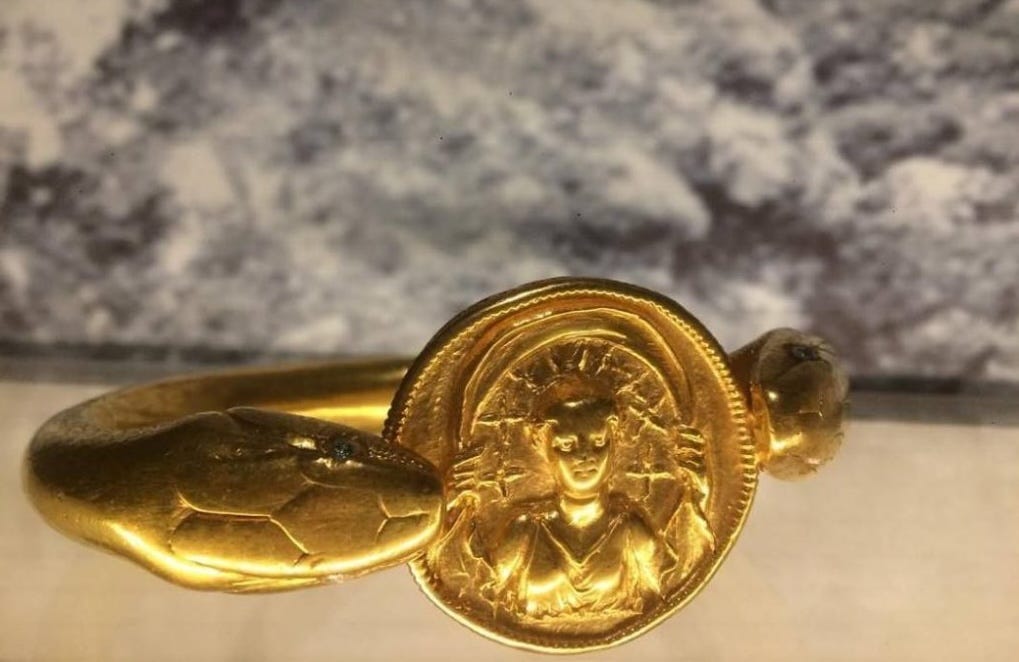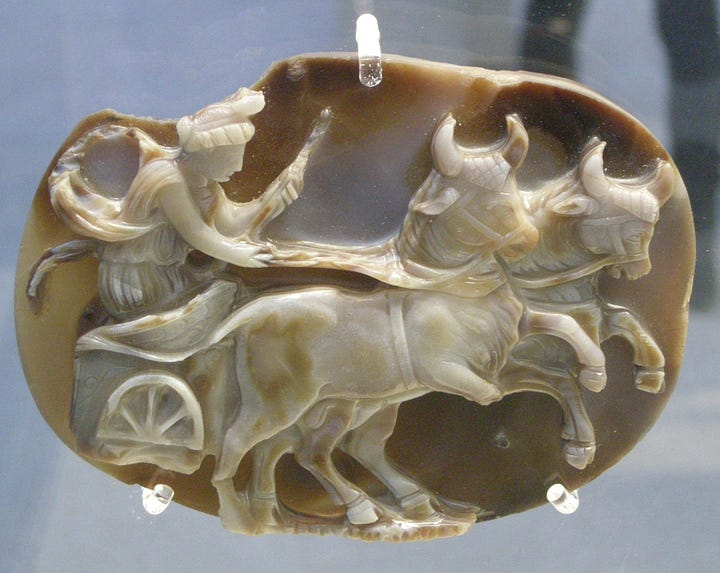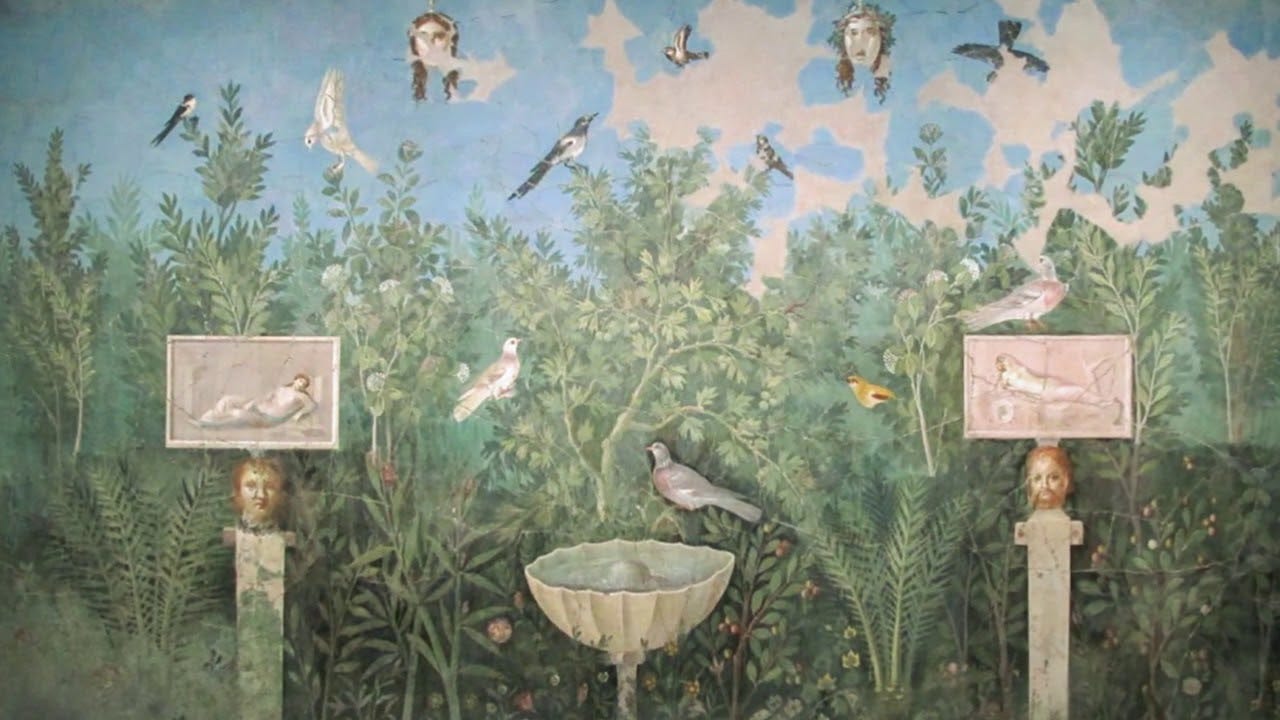The Bracelet that Survived Pompeii's Eruption
A golden cuff found in the shadow of Mt. Vesuvius
Ciao a tutti! I’m so happy to be kicking off The Jewelry Casket with one of my favorite pieces from the ancient world! The two-headed snake bracelet from the House of the Golden Bracelet in Pompeii.

This gorgeous solid gold bracelet was found in the eponymous House of the Golden Bracelet, one of the most elegant houses in Pompeii’s Regio VI, in what is known as the Insula Occendentalis. The three-story house is famous for its spectacular illusionistic garden frescoes and luxurious floor decoration, mainly its colored marble mosaics (opus sectile). Mythological paintings and reproductions of original Greek works of the 4th century can also be found in this grand complex!
The bracelet is composed of a curved shaft with terminals in the shape of serpent heads grasping a central disc between their jaws. The disc is decorated with the bust of the goddess Luna (Selene), depicted as a young girl crowned by seven stars and a crescent moon above her head. Her arms are lifted as if pulling back a thin veil, billowing dramatically behind her.
The bracelet was worn by one of the victims trying to flee during the volcanic eruption. Incredibly, it was found intact and gleaming on the arm of its long-passed owner. According to Barbara McManus:
The woman was also carrying a casket containing 40 aurei and 180 denarii, indicating that they were people of ample means.1
The bracelet is so incredible, that the house where it was found was immediately named after it, eclipsing the fantastical wall paintings and garden views. While the eruption and scorching temperatures meant the demise of the city’s inhabitants, the preservation of the bodies, objects, and paintings is due to the protective layer of volcanic ash and pumice that buried the city.
Gold & Value
Numbers incoming, bear with me!
For some context into the value of the bracelet, it’s important to keep in mind that, in the ancient world, jewelry did not act solely as an accessory but as a ‘portable banking system.’2 Jewelry allowed people to wear their wealth, storing and displaying it simultaneously in an age before widespread banking.3 Think of wearing your nest-egg pile of gold coins as a pair of earrings, necklace, or stunning bracelet instead of locking them away in a safe.
The overall value of a piece of jewelry was often equivalated with the weight of a single golden aureus (the standard gold coin for the Roman period) which, in the latter part of the 1st century, was measured at 7.2 g – this was also the average worker’s salary for an entire month!4
The bracelet weighs a whopping 610 g (roughly 1.3 pounds). That means this bracelet was worth nearly 7 years’ wages in gold value alone! (83.9 months). To say nothing about craftsmanship, time, design, and other possible labor costs. It is truly an exceptional example of, not just wealth, but Pompeian craftsmanship and creativity!
Snakes & Goddesses
I don’t know about you but I hate snakes. They terrify me. But, in the ancient world, they were seen as positive symbols for renewal, rebirth, and fertility! You can find snakes in wall paintings, shrines, and yes, even jewelry! Actually, snake bracelets, arm bands, and rings were extremely popular and many examples have been found in Egypt, Italy, and Greece.
Snakes were sacred to many deities including Aesclepius, the god of medicine; Isis, the Egyptian goddess of love and fertility; the demi-god Hercules, who tied two snakes together when they were sent by Hera to kill him as a baby (yikes!), and Demeter, whose chariot was pulled by snakes. Considering the popularity of snakes as powerful guardians and symbols, it makes sense that they would be used in the bracelet’s design.


The central disc of the bracelet portrays the Roman goddess Luna, who was considered to be the divine embodiment of the moon itself! Her Greek counterpart is the goddess Selene, who evolved, and was eventually merged with, the goddess Diana/Artemis. However, there was a great period when Luna was worshiped independently from Diana and the Greek Selene. Varro, an ancient Roman polymath and author, actually categorizes her among the 20 principal gods of Rome, distinct from Diana who appears on the list as well.5
Like the gods Helios and Sol – who were also eventually merged under Apollo –Luna/Selene drove a chariot led by bulls! The goddess was also included in the Cult of Mithras, a mystery Roman religion surrounding the figure of the bull, due to the horn-like appearance of the crescent moon above her head.
Like many artifacts from the ancient world, it’s difficult to know who made the bracelet and its design, much less who commissioned it and for whom. However, I think we can all agree that it is one of the most beautiful examples of Pomepian artistry and goldsmithing in existence!
Thank you for reading my musings and ramblings! If you liked this post please hit that <3 button and subscribe for more.
Barbara McManus, PompeiiinPictures, “House of the Golden Bracelet,” notes on the solid gold bracelet.
Nicola Barham, “Cat. 160 Pair of Earrings: Curatorial Entry,” in Roman Art at the Art Institute of Chicago (Art Institute of Chicago, 2016), para 2.
Barham, “Cat. 160 Pair of Earrings: Curatorial Entry,” para 2.
Varro, as preserved by Augustine of Hippo, De Civitate Dei 7.2.







Love it !!! Educational and fun all in one !!!
Loved this read. I was super fascinated by Pompeii when I visited and also by the different symbolism of snakes at that time (renewal and fertility instead of the more biblical 'evil'). The bracelet is gorgeous!